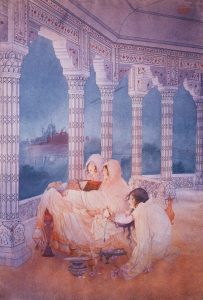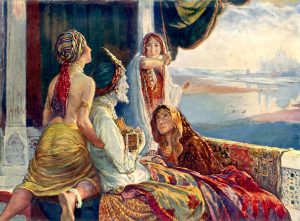THE PASSING OF SHAH JAHAN BY M.A. RAHMAN CHUGHTAI
ALL NEW SIR CECIL BURN’S VERSION COMES TO LIGHT

Various artists with varied imagery of same subject

Abanindranath Tagore, the Bengalli Indian Master first worked on the subject in 1897. The original was on wood and later made on paper. M.A. Rahman Chughtai got repulsed with the imagery of the Indian Master and presented his own version of same in 1920. The work was exhibited in Bombay in 1921 and won a commendation there in an exhibition show. Another version attributed to Chughtai but not by Chughtai was made famous in the 1980s. A fake by any standards. No other version was known. We came across a printed version of a version of the LAST DAYS OF SHAH JAHAN in an album and the artist was Sir Cecil Burns.

Sir Cecil Burns was born in 1863 and died in 1929. He was Curator of Victoria and Albert museum in Bombay and Principal of the J. J School of Art (Jamsetjee Jeejebhoy) in Bombay for many many years. On his planned return to England, many of his works were destroyed in a fire on Bombay docks. An unfortunate incident but among the works set on fire was a version of the LAST DAYS OF SHAH JAHAN. We present here an image for the first time in the regional history.

Different versions by artists of different cultures reflect the diversity in approach to art. Sir Cecil Burns version does not have the environment or persona of the great tragedy being illustrated by people. The Emperor does even look like a dying person and all three ladies are nor relevant to the scene. The first thing we observe is not the Taj Mahal but the rather erotic hips of the girl supporting the dying Emperor. That such a scene was possible that day is impossible and the lusty scene shows lack of consideration for the poignant subject. The other lady looks with annoying eyes at the other two and her face is full of malice too. But the daughter shown is the most absurd of them all. Holding the hands of her father, her face looks moronic like a servant. It is a scene in which Sir Cecil Burns exhibits his own hidden sexuality not the evident and not reflect the sorrow and tragedy of that moment. What more can we say? The costumes shown are all wrong in every way. The Emperor himself has no grace or edge of royalty about him. We can dissect it bit by bit, for the work annoys not soothes us in any way.

Sir Cecil Burns saw the work of M.A. Rahman Chughtai at the show in Bombay in 1921 (part of the committee) and must have thought of making his own version. The version lost in history and an image remains of same. An addition to our knowledge of the important painting which made history in India by selling for the highest sum ever paid for a modern work. It was purchased by the Prime Minister of Nepal then. Now it is Art history and a reflection of the two nation theory of our region.


Missing image will be corrected soon